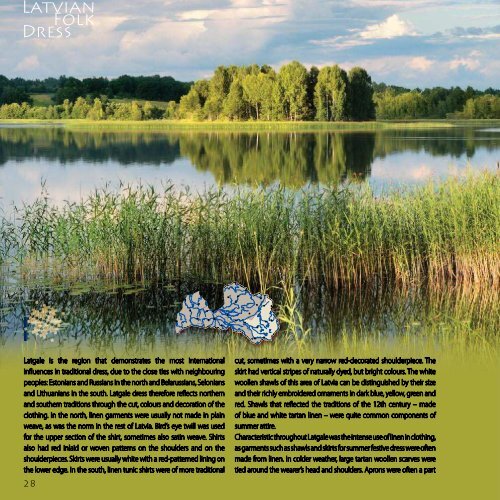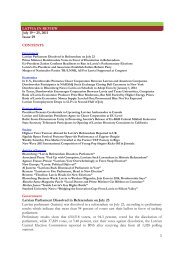Latvian Folk Dress - Latvijas Institūts
Latvian Folk Dress - Latvijas Institūts
Latvian Folk Dress - Latvijas Institūts
You also want an ePaper? Increase the reach of your titles
YUMPU automatically turns print PDFs into web optimized ePapers that Google loves.
<strong>Latvian</strong><br />
<strong>Folk</strong><br />
<strong>Dress</strong><br />
Latgale<br />
Northern and southern Latgale dress,<br />
19th century.<br />
Latgale is the region that demonstrates the most international<br />
influences in traditional dress, due to the close ties with neighbouring<br />
peoples: Estonians and Russians in the north and Belarussians, Selonians<br />
and Lithuanians in the south. Latgale dress therefore reflects northern<br />
and southern traditions through the cut, colours and decoration of the<br />
clothing. In the north, linen garments were usually not made in plain<br />
weave, as was the norm in the rest of Latvia. Bird’s eye twill was used<br />
for the upper section of the shirt, sometimes also satin weave. Shirts<br />
also had red inlaid or woven patterns on the shoulders and on the<br />
shoulderpieces. Skirts were usually white with a red-patterned lining on<br />
the lower edge. In the south, linen tunic shirts were of more traditional<br />
cut, sometimes with a very narrow red-decorated shoulderpiece. The<br />
skirt had vertical stripes of naturally dyed, but bright colours. The white<br />
woollen shawls of this area of Latvia can be distinguished by their size<br />
and their richly embroidered ornaments in dark blue, yellow, green and<br />
red. Shawls that reflected the traditions of the 12th century – made<br />
of blue and white tartan linen – were quite common components of<br />
summer attire.<br />
Characteristic throughout Latgale was the intense use of linen in clothing,<br />
as garments such as shawls and skirts for summer festive dress were often<br />
made from linen. In colder weather, large tartan woollen scarves were<br />
tied around the wearer’s head and shoulders. Aprons were often a part<br />
of the festive dress of Latgale, however they were<br />
never worn together with woven sashes. Jackets<br />
were seldom part of festive dress but when they<br />
were used they, too, excluded a sash. Later tartan<br />
skirts of various colours became popular in all of<br />
Latgale, but generally the use of the traditional<br />
dress ceased in the 1870s and 80s. Latgale was<br />
the region where industrially-produced clothes were<br />
seldom used by peasants: all garments were usually homemade.<br />
In Latgale, bast footwear from linden bark or tow cord<br />
was more popular than in other regions.<br />
28 29






